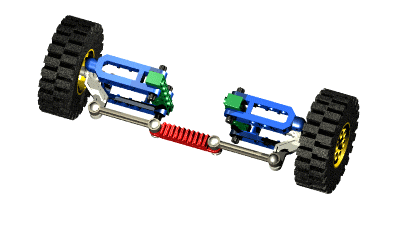Description: Many years ago, wheels were the part of a log and it slowly utilized for carts and wagons. The wooden wheel utilized was hard wood stakes. Trucks have become the backbone of the workforce in the world. They are large, strong and could be move on roughest of terrains. Truck rims should be placed if they are cracked.

The Automatic Pneumatic Bumper For Four Wheeler of truck rims are manufactured in the similar manner. It begins with tough hub and 4 to 6 holes for the bolts. Truck wheels require durable which carry some weight. Lighter wheels are developed by decreasing unsprung mass and permit suspension to follow the terrain and develop grip. Better heat conduction spends heat from the brakes that develops braking function in driving situations and decreases the brake failure because of overheating. The spun steel rim is saved with welds series. The rim is balanced and provided the smooth finishing.
The wheel rim is the portion of automotive. It includes static loads and fatigue loads like wheel rim moves various road profile. It improves high stresses in rim to search the serious stress point. The alloy of steel and light are important materials utilized in a wheel consisting glass-fiber. Different wheels are Wire Spoke Wheel, Steel Disc Wheel, and Light Alloy Wheel. The steel rims are present in silver and chrome and many finishes are secured for alloy wheels.

The important components of the project are,
• IR transmitter
• IR receiver
• Control Unit with Power supply
• Solenoid Valve
• Flow control Valve
• Air Tank (Compressor)
The IR TRANSMITTER circuit is to transmite the
Infra-Red rays. If any obstacle is there in a path, the Infra-Red rays
reflected. This reflected Infra-Red rays are received by the receiver circuit
is called " IR RECEIVER".
In
this project, we have to apply this breaking arrangement in one wheel as a
model. The compressed air drawn from the compressor in our project. The
compressed air floe through the Polyurethene tube to the flow control valve.
The flow control valve is connected to the solenoid valve as mentioned in the
block diagram. The application of pneumatics produces smooth operation. By
using more techniques, they can be modified and developed according to the
applications
Conclusion:
The important components of the project are,
• IR transmitter
• IR receiver
• Control Unit with Power supply
• Solenoid Valve
• Flow control Valve
• Air Tank (Compressor)
The IR TRANSMITTER circuit is to transmite the
Infra-Red rays. If any obstacle is there in a path, the Infra-Red rays
reflected. This reflected Infra-Red rays are received by the receiver circuit
is called " IR RECEIVER".
In
this project, we have to apply this breaking arrangement in one wheel as a
model. The compressed air drawn from the compressor in our project. The
compressed air floe through the Polyurethene tube to the flow control valve.
The flow control valve is connected to the solenoid valve as mentioned in the
block diagram. The application of pneumatics produces smooth operation. By
using more techniques, they can be modified and developed according to the
applications
The wheel rim is the outer circular concept of the metal where corner of the tyre is climbed on automobiles like vehicles. The automotive steel wheel rim is created with rectangular metal. The metal plate is made curved to generate the cylindrical sleeve with the two corners of the sleeve joined together.










